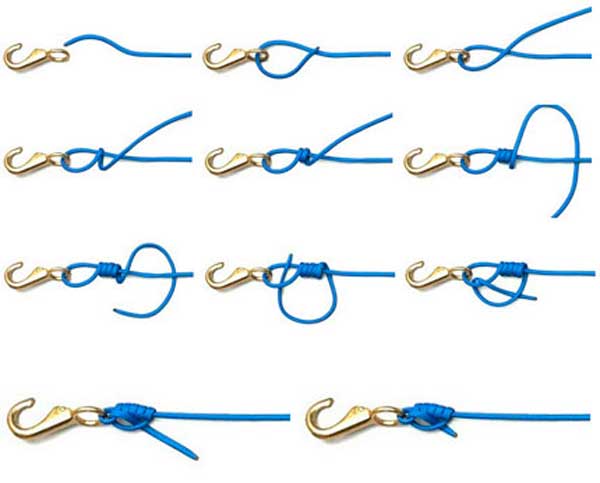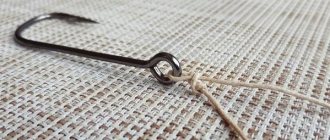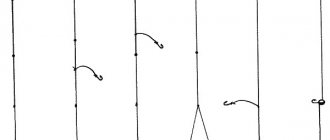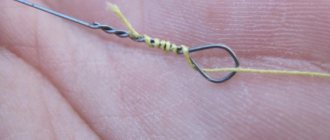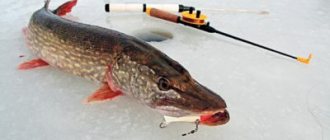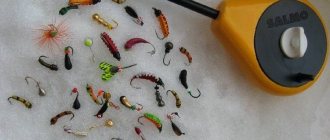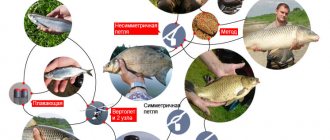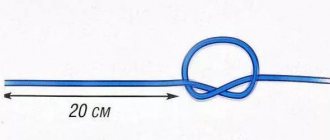The swivel is the main element of any fishing equipment, and it plays an important role in it. Therefore, every fisherman must understand how to tie a swivel to a fishing line and with what kind of knot this can be done, so that there are no troubles later. There are a lot of ways to tie swivels, but you don’t need to know everything.
Among the many ways to tie a swivel to the main line, there are a lot of complex, weak and unreliable knots. Of course, few people are interested in such nodes, so we will not talk about them in our article. We have left only the correct, reliable and simplest options.

Basic methods
The most popular methods of how to properly tie a swivel to a fishing line are about 10 knots, but we will not consider all of them, but only the simplest part. We will only describe complex nodes a little, and then devote a separate article to them. And so, the simplest methods are considered to be the following:
- Fastening with a palomar knot
. The knot is considered one of the most common due to its simplicity and versatility - it is suitable for fishing line and braid. It is tied quite simply, quickly and securely. - Clinch knot
. A very useful and good node, to which we have already devoted an entire article. Using it to tie a swivel to a fishing line is quite simple and secure. - Fastening using a greenner knot
. A strong and secure knot that is suitable for tying fishing line to fishing line, hooks and swivels. - Figure eight knot
. Quite strong and at the same time simple knot. Allows you to use a variety of materials, from regular fishing line to braided cord. - Tying with double knots
. Knots fail very rarely; many people know this from personal practice. But, for unknown reasons, they were not widely used. - Method of fastening with a hangman's knot
. One of the oldest knots, which is easy to tie, but at the same time it is quite reliable. It was used by English fishermen as early as the 17th century for sea fishing - Jensik knot
. The knot came to us from abroad quite recently, but has become widespread among domestic fishermen. The simplicity and strength of the knot can be the envy of many.

Quite an interesting way to tie a swivel to a fishing line, isn't it? Now let's take a closer look at the best way to tie a swivel to fishing line, braid and fluorocarbon fishing line. So that everyone can choose for themselves which knot to tie the swivel to the fishing line.
How to tie a swivel to braided fishing line?
The first node we will tell you about is called “Palomar”. It is worth noting that it is also suitable for monofilament. The simplest of knots.
To connect it, you need to do the following:
- Fold the end of the fishing line in half so that the double end is ten centimeters long, thread the folded end into the eye of the swivel;
- Now tie a simple loop knot with the double end of the line over the swivel, without tightening it. The goal is for the swivel to be on the bottom after tying, inside the loop;
- If everything is done correctly, the result is a loop, on one side of which there is a small loop from the folded tip of the fishing line, and the swivel is located at the bottom of the large loop. Place a small loop on the swivel;
- We thread the swivel through the large loop. Tighten the knot. We cut off the remaining tip of the fishing line.
Step-by-step knitting of the Palomar knot:
The second knot, which is often used by fishermen, is called the “Reinforced Clinch”. Can also be used on fluorocarbon line. It should not be confused with a simple “Clinch”; it is only suitable for monofilament and is not recommended for use on braid and fluorocarbon.
To tie “Reinforced Clinch”, you need to perform the following steps:
- Fold the end of the fishing line in half so that the double end is fourteen centimeters long, thread the folded end into the eye of the swivel;
- Fold the double end threaded through the eyelet to the main line so that the folded part is five or six centimeters long;
- With the remaining single tip of the fishing line, wrap the main and double fishing line folded together, making at least five turns;
- If everything is done correctly, you will end up with a double and main line wrapped together. There will be a small loop at the end of the double line attached. We thread the tip into it, which was used for winding.
- Tighten the knot. Trim the remaining tip of the line.
To the fishing line
First of all, I want to consider installation options with regular fishing line (which is the most popular among fishermen). Fishermen identify two main units for such needs. We have already described the first node above, and it is called Grinner. They can be used to tie not only fishing line
.
Technique for tying a swivel to a fishing line using a Grinner knot
happens as follows:
- Pass the end of the line through the eye of the swivel and pull the edge about 15 centimeters;
- Now you need to lay the free end over the fishing line to make a loop;
- Now take the working end and wrap it around the fishing line about 5-7 times and insert it into the first loop;
- You will get another loop, so you need to stretch the free end of the fishing line into it;
- Wet the line with water and tighten the knot;
Do not cut off the entire line, leave a free end about 1.5 millimeters long
so that the knot does not come undone.
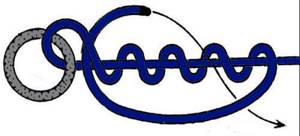
Also, domestic fishermen quite often use the Homer knot
, if a connection with a regular fishing line is required. Its load capacity and strength are not inferior to those described above. Let's look at the diagram and step-by-step installation instructions:
- We take the main fishing line and pull it through the swivel ring, leaving about 15 centimeters free;
- We wrap the remaining end around the main fishing line to form a loop (see picture);
- Now take the end of the fishing line and pull it through the resulting loop;
- Now you need to take the fishing line itself and wrap it around its axis 4-6 times;
- Thread the end of the fishing line into the resulting loop;
- Moisten and tighten the knot.
When you tighten the knot, be sure to pull on two lines at the same time. Try to move the knot as close to the eye of the swivel as possible.
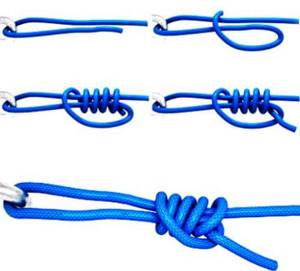
These were the two most common, durable and simple mounting options for regular fishing line. Now, I think it's time to move on to something else. Namely, consider how to tie a swivel to a braided fishing line. Let's get started.
Knots for attaching the swivel to monofilament fishing line
The first knot, which is most often used to attach a swivel to a monofilament line, is the Grinner .
Its strength in practice is eighty-five percent, which is a good result. In addition, this unit has the following advantages of its use:
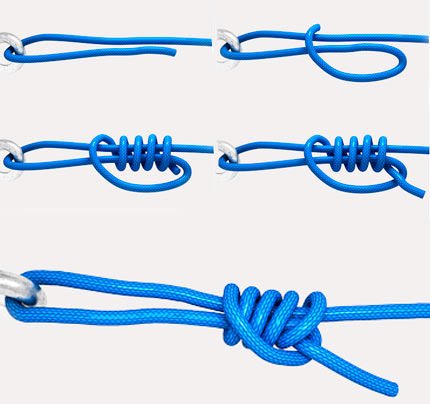
- has very good load capacity;
- in addition to the swivel, they can be used to tie hooks and sinkers (carp);
- shows long-term service;
- easy to perform;
- Doesn't take long to tie.
The Grinner knot is tied in this way:
- First you need to thread the tip of the monofilament line into the swivel ring. The total length of the fishing line used must be at least eighteen centimeters.
- Take the other end of the fishing line and fold it in half to make a loop.
- Pinch the area where the two ends of the lines intersect with your fingers and wrap the line folded in half with several turns. There must be at least six windings. If there are fewer turns, the knot will be too weak.
- Pull the other end of the fishing line into a larger loop and begin to slowly tighten the knot. Before doing this, you need to moisten it with a small amount of water.
- When pulling the line through the main loop, move the knot towards the swivel loop.
- After stepping back two millimeters, carefully cut off the excess fishing line at its tip.
The second knot, which is used to tie the swivel to the monofilament line, is called "Homer" . Its advantage is that its strength in practice is ninety-eight percent, which indicates its incredible reliability when tied correctly. For this reason, this knot is very popular among many fishermen.
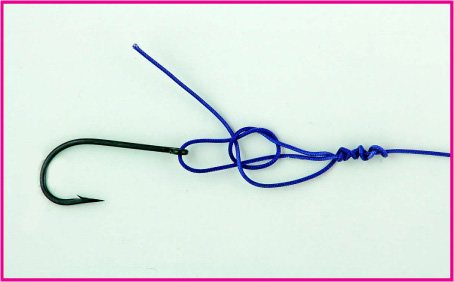
The Homer knot is knitted in the following sequence:
- Measure out fifteen centimeters of fishing line.
- Pull one end of the line into the eye of the swivel.
- Wrap the working tip of the fishing line twice along the main fishing line and pull it into the resulting loop.
- Do not tighten the resulting knot, but hold it with your hand, while winding the other end of the fishing line around the main fishing line six to eight times.
- Pull the other end of the fishing line into this loose loop.
- Tighten the main and working lines at the same time, after wetting them.
- Push the resulting knot towards the swivel ring so that it rests directly on the eye of the fastener.
- After retreating two millimeters, cut off the excess fishing line.
To the braid
There are several ways to tie a swivel to braid. But the simplest and most reliable knot is called Palomar
.
It can also be used to tie a regular fishing line
, but it still shows its qualities better on a braided cord. The execution sequence of the node is as follows:
- Take the free end of the main fishing line, about 10 centimeters long, and fold it in half;
- Now pull the double loop into the eye of the carabiner (as in the diagram);
- Tie a regular knot, but do not tighten it;
- Place the swivel at the bottom of the large eyelet;
- Now put a small one on top of it (see the diagram so as not to get confused);
- Pull the swivel through the large loop;
- That's it, all that remains is to tighten the knot.
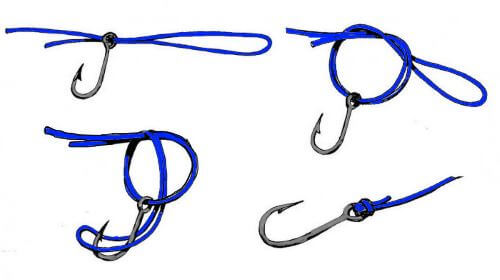
Also an excellent knot for such purposes is the reinforced Clinch knot
. But it has a significant drawback - it is not suitable for tying on thick fishing line and is used only on medium-diameter ears made of thin wire. The node execution sequence is as follows:
- The end of the fishing line must be threaded through the eye and pulled back by about 15 centimeters;
- Fold the fishing line in half;
- Wind the free end around the main line 5-10 times;
- Now pull it through the formed loop;
- And again pull the free end into the large loop obtained as a result of the action in step 4;
- Wet the knot and tighten it.
It is very important when tightening to ensure that the free end does not fall out of the main loop.

Knots for attaching a swivel to a braided line
To tie a swivel to a braided line, the following types of knots are used:
Knot "Palomar". It is considered the simplest fishing knot and can also be used on monofilament fishing line. The “Palomar” is tied in this way:
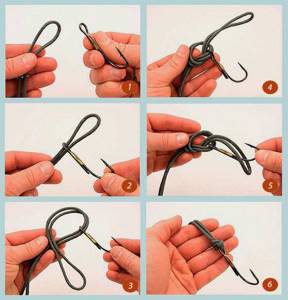
- The tip of the fishing line must be folded in half so that the length of the resulting folded segment is at least ten centimeters.
- Pull the folded end of the fishing line through the ring of the swivel.
- Make a regular knot over the swivel. There is no need to tighten it. The swivel should appear to be inside the loop.
- If done correctly, you should have a loop coming out, with another loop coming out on one side, and the swivel located under the first large loop.
- Throw a smaller loop onto the swivel.
- Pull the swivel through the large loop.
- Moisten the knot and tighten it.
- Trim off excess line.
The “Clinch Reinforced” knot has a strength of more than seventy-eight percent. You should know that it should not be used for tying hooks with a small eye. The main advantage of such a unit is its simplicity of execution and reliability.
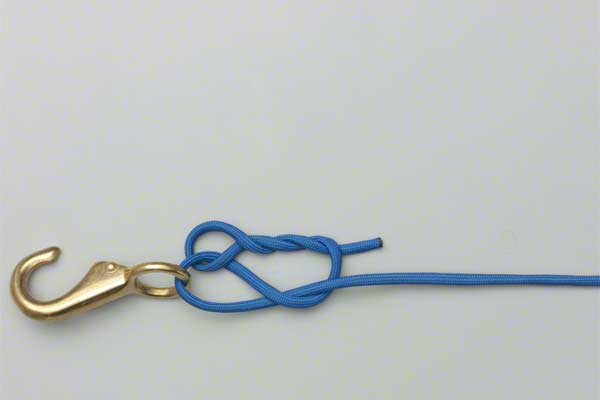
It fits like this:
- Fold the fishing line in half so that the resulting folded segment is at least fifteen centimeters long.
- Pull the resulting loop into the eye of the swivel.
- Pull this line so that the unused end of the loop is nine centimeters long.
- Make five turns of this loop tip around the main line.
- Pull the tip of the fishing line into the loop formed and pull it slightly.
- Next you need to pull the main line so that the working tip of the line does not fall out of the loop.
- Pull the main line, and at the same time pull the other end of the line from time to time. Moisten it with water and tighten completely.
- Trim the excess line, leaving only two millimeters near the knot.
To fluorocarbon line
a Rapala knot is used to mount a swivel on a fluorocarbon line.
. It is considered one of the most reliable units for this type of task. If you look closely at the knitting process, you can see its similarity with the knots mentioned above. But, besides this, the Rapala knot is very often used when tying spinners and wobblers.
Knot technique:
- You need to tie an ordinary knot on the fishing line;
- Then pull the line through the eye of the swivel and thread the free end into the knot tied earlier;
- Wind the free end around the main line 4-6 times;
- Pass the free end of the line through the loop;
- Pull the fishing line through the loop obtained in step 5;
- Moisten and tighten the knot.
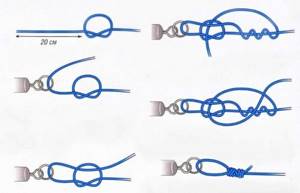
Rapala
If a movable connection is required, it is worth using the Rapala knot.
Grinner (universal)
This type is ideal for attaching a swivel to a fishing line when a large predator is expected to be caught. There are known cases when individuals weighing up to 70 kg were fished on rigs knitted using “Grinner”.
- Fold the fishing line in half and pass it through the eye.
- Pull the loop up to 15 cm.
- Connect the loop to the main line so that another small loop is formed.
- If you plan to fish for a large predator, the knot is strengthened by twisting it at least 5-6 times, and only after that it is tightened to the required rigidity.
A swivel tied in this way is considered among fishermen to be the most durable and “load-lifting”.
Without node
When spinning fishing, a knotless connection is very often used. The main purpose of which is to eliminate weak points in the equipment, because as you know, most often the fishing line breaks at the knots. Let's take a closer look at how to tie a swivel to a fishing line without a knot.
The advantages of such a connection are numerous. This includes the absence of destruction of the fiber structure and minimization of line deformation. It also makes it possible to quickly replace the bait in poor lighting or weather conditions.
The main and most important element of such gear is the clasp. A swivel or a metal leash is attached to it, or all together (depending on your personal preferences and the characteristics of catching the selected type of fish). As personal experience shows, it is not at all necessary to use a swivel, since the tackle rarely gets twisted. Only this type of installation can only be used in combination with braiding
.
If you are interested in how to tie a swivel to a fishing line using a knotless connection, then I suggest moving on to the step-by-step instructions:
- on the side of the longitudinal bend, a connecting element (spinner, wobbler, leash) is strung;
- the fishing line is folded in half, forming a loop 3 cm long;
- the tip of the loop is put on the bend;
- the fastener rod is wrapped 4-5 times in the direction of the bent transverse bend;
- by pulling both branches, the fishing line is inserted under the bend into the fastener loop.
How to tie a swivel to fluorocarbon line?
To attach a swivel to a fluorocarbon line, many anglers use a Rapala knot.
In order to connect it, you need to do the following:
- Step back ten centimeters from the tip of the fishing line, tie a loop without tightening it;
- Thread the tip into the ring of the swivel, wrap it around the loop and thread it through;
- Make three turns around the main line and wrap the tip back towards the loop. Thread the end into the loop. You will get two loops - large and small.
- Thread the tip through the large loop. Tighten the knot. Trim the remaining end of the line.
Rapala knot:
Video
This method of tying a swivel can compete for a place among the best. Easy to remember, easy to perform - in general, everything we need. Although, the first time, this method of tying a swivel may not seem very convenient, but after a while you will adapt, and all difficulties will be forgotten. Let's take a look and practice.
https://youtu.be/_4kGbgPHVoE
Knots “Clinch”, “Diamond”, “Eight”
In this video you will see three cool ways to tie a swivel to a fishing line. Thanks to this knowledge, you will provide yourself with reliable fishing knots for all occasions. These nodes and the first method will be quite enough for you. Don't bother with too many options.
All the same, in the end you will choose for yourself one that seems most convenient to you and you will almost always use only it. And of course, these knots can be used to tie not only a swivel, but also other elements of fishing gear, such as a hook, feeder, etc.
Clasp
When equipping both fishing lines with hooks, weights, floats, and feeders, fishermen use various knots for attaching them, as well as various knitting technologies. At the same time, the nodes should be as simple as possible, but reliable. Fishermen mainly use “wet” knot tying technology. It consists in the fact that the fishing line, while tying a knot, is moistened with water or simply saliva. Very often, before tying knots, the fishing line is kept in hot water for some time and only then the knot is tied. An increase in temperature makes the line more elastic, and the knot becomes more reliable.
The best option is to prepare your gear before fishing at home. Here you can use and tie any knot, securing any fishing accessory. But it is impossible to predict everything and, sometimes, you have to update your gear during the fishing process. Of course, it will be difficult to tie a complex knot, and therefore in the fisherman’s arsenal, simple knots that can quickly and efficiently change the design of the gear should be prepared and tested.
Braided fishing line is produced by manufacturers from various materials, and therefore they recommend using certain types of knots for their products. For example, for the “Power Pro” fishing line it is recommended to use the “Uni knot” knot, and for the “Fire Line” fishing line - the “Palomar knot”.
How to tie a clasp
Until recently, fishermen knew nothing about the fastener (carabiner), and the elements of the gear were rigidly attached to the main line, not removable. It was impossible to make any home preparations in such conditions, and replacement of weights and feeders had to be done at the fishing site. Only the fishermen know how long these replacements take, since they had to constantly tie knots. And when hooked, sometimes the entire tackle was torn off right up to the rod. The appearance of fasteners marked a new level in the development of this wonderful pastime. The fastener allows you to very quickly replace weights, feeders, baits, experiment with leashes, quickly replacing leashes of different lengths. And the most important thing is that you can prepare everything at home, and during the fishing process, just take it and quickly update your gear. Not fishing, but pure pleasure!
Carabiners (clasps) and swivels are selected depending on the power of the gear. Usually they try to use small ones so that this element of the tackle does not scare away the fish. Snap hooks and swivels (by the way, there are sets - snap hook + swivel) have special ears, by which they are attached to the main fishing line. A reliable and good knot is a universal knot (Uni knot).
How to tie a Uni-Knot (AKA Hangman's Knot) by Abu Garcia
It is also called the "Hangman's Knot"). It works great on mono, braid and fluorocarbon. A very simple Offshore Swivel-knot.

The technology for tying this knot is simple and comes down to only a few turns of the fastener around its own axis, after which you just need to pull the edges of the fishing line.
What you need to know
- It is better not to use a swivel that has a rough eye, as it can be sharp for the fishing line and fray it;
- before tightening the fishing line, you should always wet it so that the knot lasts longer and is stronger;
- a novice fisherman who is just learning to tie knots should try making them on a textile cord;
- the more turns the knot has, the stronger it will be, so you need to try to make a lot of turns;
- when you tighten the knot, you don’t need to rush, because too fast and sharp jerks make the knot much weaker;
- It is very convenient to cut off the excess fishing line from the knot using nail clippers;
- if the fisherman has doubts about the strength of the tie, then it needs to be bandaged; a reliable knot will not have gaps or distorted areas of the line;
- It is advisable to practice a lot so that at the right moment the fisherman can easily tie the knot he needs.

These were the most popular and effective knots that will help you understand how to tie a swivel to a fishing line. By following the recommendations, the fisherman will be able to tie the tackle correctly so that it does not fail him at the most inopportune moment.
Blitz tips
- Be sure to wet the line before each time you tighten the knot, as this is very important.
- Those fishermen who do not yet have residual experience in tying fishing knots are recommended to first practice on twine or textile cord. With such materials it will be much easier to follow and remember the algorithm for tying one or another type of knot.
- There is no need to rush when tying knots, since quick and sharp jerks of the fishing line significantly impair the reliability of the future knot.
- Small tweezers (for manicure) are considered the best device for safe and convenient cutting of fishing line. The use of a knife in this matter is extremely undesirable, since it can damage the assembly.
- If you are unsure of the reliability of the knot you have tied, then you should not take risks and use it in practice. It's better to re-tie the knot.
- Reliable knots require a lot of training and perseverance from the angler, so the latter must practice often, and only then will the knot be obtained according to all the rules.
Types of binding
It would be useful for every fisherman to have in his arsenal several ways of tying a swivel for a particular gear.
When should you use this type of mating like palomar?
This method is most used for monofilament fishing line and braided line. How to tie a swivel to a fishing line in this way?
- an indentation is made 50 cm from the end of the thread and bent;
- the thread is threaded through the swivel, and it should be at a bend of 50 cm;
- then a simple knot is made, but with a double line and is not tightened to the end, forming a loop lower to the swivel, and the edge and the main part of the thread should remain above;
- the swivel passes into the loop from the side of the bent line and is tightened.
This type of unit is designed for heavy loads and is designed for catches of overall dimensions. Suitable for all types of thread.
The figure eight is one of the simplest knots
It is considered a universal knot; its great advantage is the fact that the fishing line does not break during its formation. To get an eight you need:
- fold the fishing line in half at a distance of 20 cm;
- thread the swivel;
- lay the fishing line on top of each other in the form of a figure eight;
- do not forget to moisten;
- tighten.
Recommended reading: Details about spring feeder fishing
Wetting is important with any knot tying, but for the figure eight it is necessary because the knot will not tighten properly.

Rapala for loops that don't require tightening
Anglers mainly use this type of knot for wobblers or spoons. It allows the tackle to move freely. To get it you need:
- tie an ordinary knot that is not fully tightened on the thread;
- pull one end of the thread into the hole of the swivel into the original non-tightening knot;
- wrap the first end around the main thread 5 times;
- for a loop to appear, you need to thread the first end of the thread into the knot;
- then unfold the same tip of the thread into a new loop that appears from above;
- moisten with water and tighten;
- cut off excess.
As a result, the swivel should run along the line in a loop, and the loop itself should be securely tightened.
Grinner for any threads and fishing lines
This type of fastening can be applied to anything, and it is designed for heavy loads, thanks to a special knitting method:
- pull the end of the thread into the hole of the swivel at a distance of no more than 15 cm;
- the rest of the thread must be placed on the main thread to form a loop;
- holding the top loop, wrap the edge of the thread 3-4 times around the main one;
- pull it through the loop at the top again;
- wet and tighten.
This type of binding is the most common because it is simple and can be used on any gear.

Homer for monofilament lines
An unusual and strong enough knot for its purpose, it holds in 90% of cases. To begin with:
- pull the thread into the swivel hole;
- then turn part of the thread, which should be about 20 cm, once around the main thread and tighten it into the loop below;
- a knot that has turned out cannot be tightened;
- wrap the edge of the thread 6 times around the main part;
- pass the edge into the top loop, which is above the knot;
- wet and tighten.
Such a knot is similar to a grinder, but here, in the end, there will be a loop between the knot and the swivel, just as an angler uses monofilament fishing line.
Clinch and its features
This fastening method is only suitable for monofilament types of fishing line with a diameter of 0.4 mm, but no more. For this node you need to do the following:
- the end is inserted through the ear at a distance of 15–20 cm;
- the thread bends after threading and is pinched with your fingers;
- 7 turns are made and the edge of the thread passes through this loop, and then through the first;
- after 2 threadings through 2 loops, a third pass occurs where winding occurred 7 times;
- The edge of the thread is passed between them (turns) and tightened, after wetting it.
We recommend reading: Characteristics of spinning reels, tips for choosing them
This is a very complex type of knitting, but it is considered the most reliable application for this thread.
